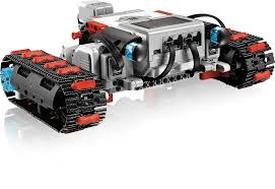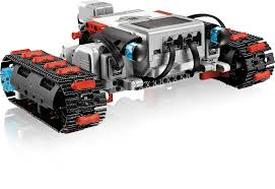ITS ALL JUST FUN COMPETITION
The competitors have many matches and learn to make modifications and alterations to improve the effectiveness of their machines. Every robot has features that provide mechanical advantage over every other robot. Competitors are quick to point out the ingenuity and resourcefulness required to build and operate each robot. They offer each other advice and congratulate their fellow campers at each and every event. The sportsmanship and cooperation is inspiring.
We are fortunate kids form strong friendships and have learned the meaning of fair play and good sportsmanship. If this were not the case, we might need security for our robotics curriculum.
The competitors have many matches and learn to make modifications and alterations to improve the effectiveness of their machines. Every robot has features that provide mechanical advantage over every other robot. Competitors are quick to point out the ingenuity and resourcefulness required to build and operate each robot. They offer each other advice and congratulate their fellow campers at each and every event. The sportsmanship and cooperation is inspiring.
We are fortunate kids form strong friendships and have learned the meaning of fair play and good sportsmanship. If this were not the case, we might need security for our robotics curriculum.
SUMO:
Robotics can include other electrifying competitions. The campers have designed robots that adhere to specific size a weight regulations. This particular game is based on the ancient art of “Sumo”. The kids carefully design robots that have superior leverage, maneuverability and power. Robots face off opposite each other and wait for the indication for commence “robot warfare”. The robots fight for position and attempt to push their opponents outside the designated boundaries. The contestants develop a working knowledge of important principals of mechanical advantage. Mass, weight, momentum, force, linear and angular momentum are just a few concept the participants must consider when building and controlling their individual specialized contraptions. Each team attempts to push the other team's robot or robots off the playing field. After the encounter, only one team remains. After a few adjustments, the combat-tested adversaries upgrade their robots and compete again.
SOCCER-BOTS:
Each robotic team lines their robot up on opposite sides of the “soccer field” and wait for the signal to begin. Teams command their robots via blue tooth connections and joy sticks. They try to score by directing the ball into the goal.
The youngsters manufacture innovative designs for their Soccer-Bots. They have been inspired by the World Cup Soccer.
Robotics can include other electrifying competitions. The campers have designed robots that adhere to specific size a weight regulations. This particular game is based on the ancient art of “Sumo”. The kids carefully design robots that have superior leverage, maneuverability and power. Robots face off opposite each other and wait for the indication for commence “robot warfare”. The robots fight for position and attempt to push their opponents outside the designated boundaries. The contestants develop a working knowledge of important principals of mechanical advantage. Mass, weight, momentum, force, linear and angular momentum are just a few concept the participants must consider when building and controlling their individual specialized contraptions. Each team attempts to push the other team's robot or robots off the playing field. After the encounter, only one team remains. After a few adjustments, the combat-tested adversaries upgrade their robots and compete again.
SOCCER-BOTS:
Each robotic team lines their robot up on opposite sides of the “soccer field” and wait for the signal to begin. Teams command their robots via blue tooth connections and joy sticks. They try to score by directing the ball into the goal.
The youngsters manufacture innovative designs for their Soccer-Bots. They have been inspired by the World Cup Soccer.
The campers perform various programming behaviors can be obtained through artificial simulation first. However, the majority of these systems have been obtained and tested in simulations without being validated on real robots. Although robot to performs some desired task.
Pupils generalize and use trials to create efficient function in a supervised environment. Here, regression errors are decreased by using models from RVW. The predictions of these simulated models help with actual performance when campers compete. Using virtual robotic systems allows students to quickly test actions due to the many angles and velocities. These factors must be taken into account prior to employing any tactics on the field of play. The robot’s actions would be the generated motor commands, which often are torques or accelerations. They use what RVW programs teaching them to write. They are sure to start with a new template program from that is guaranteed to function properly. They check with the instructor when programs are complete:
Warm-up Activity: Students write phrases and draw pictures about what they know about Sumo wrestling
Campers are asked to share what they know about Sumo.
Campers learn that Japanese wrestling contest in which two participants challenge each other within a defined area to see who can be the last standing. ( Its best to have an even number of groups for robo-Sumo matches)
Campers are asked to share what they know about Sumo.
Campers learn that Japanese wrestling contest in which two participants challenge each other within a defined area to see who can be the last standing. ( Its best to have an even number of groups for robo-Sumo matches)
LEGO Mindstorm kits
Computers (one per robot for the competitions)
A surplus of equipment
Programming software (on each computer)
Internet connection (Everyone)
Sumo video, Could You Be a Sumo Wrestler?, National Geographic (http://www.youtube.com/v/vJ1wnbNIUrc) (embedded in Power Point)
30 cm diameter paper for students to measure robot
Scale for students to weigh robot
Variety of prizes for winners and all students
Computers (one per robot for the competitions)
A surplus of equipment
Programming software (on each computer)
Internet connection (Everyone)
Sumo video, Could You Be a Sumo Wrestler?, National Geographic (http://www.youtube.com/v/vJ1wnbNIUrc) (embedded in Power Point)
30 cm diameter paper for students to measure robot
Scale for students to weigh robot
Variety of prizes for winners and all students
Examine how your interests & skills connect to CS
Explore paths to careers
Consider next steps
Learn a bit about Computer Science
Give it a try!
Explore paths to careers
Consider next steps
Learn a bit about Computer Science
Give it a try!

